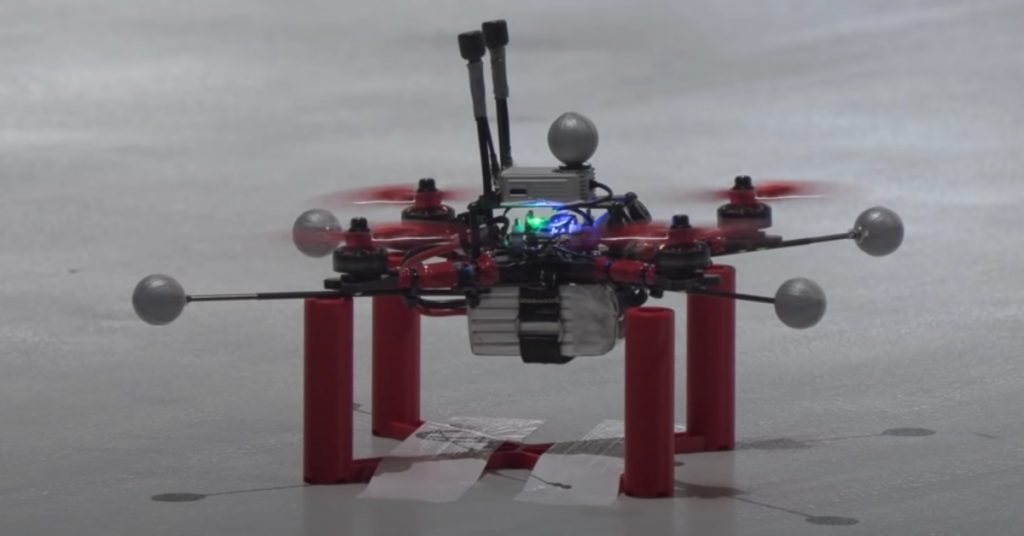AI Algorithm Beats Two World-Class Drone Racing Pilots in a Race for the First Time Ever
BY Zacc Dukowitz
28 July 2021A drone flying autonomously recently beat two world-class drone racing pilots in a race.
The drone’s flight was made based on an algorithm developed by researchers at the University of Zurich (UZH), who received funding for the project from NCCR (National Centre of Competence in Research) Robotics via its Rescue Robotics Grand Challenge.
The algorithm works by calculating time-optimal trajectories that not only consider the fastest route for the drone, but also factor in the drone’s technical limitations.
Put simply, it finds the fastest route between any two waypoints on a circuit and then precisely repeats that route every time it flies.
Researchers have previously tried to use autonomously-piloted drones to beat drone racing pilots but all those attempts have failed, making this the first time ever that an autonomous drone has beaten a professional drone racing pilot.
How the Race Was Conducted
Researchers had both the professional drone pilots and the autonomously-piloted drone fly a drone race track at different times, closely monitoring their performance and timing of completion.
External cameras placed around the track captured the exact location of each drone while going through the track. This information was used both to monitor the performance of the pilots and to train the AI algorithm with real-time data on where it was on the track.


To make the test fair, the pilots were given the chance to practice on the track before the official races were made.
But despite that training, the algorithm won.
Our drone beat the fastest lap of two world-class human pilots on an experimental race track.
– David Scaramuzza, Head of the Robotics and Perception Group at UZH
And the algorithm wasn’t just faster, it was more consistent across laps. Once it found the optimal path around the track it reproduced it perfectly, which is something human pilots don’t seem to be able to do.
Why Is This Important?
The development of an algorithm that can fly a drone faster than a person has implications for many other drone operations, not just drone racing.
Here are some specific applications where the speed and efficiency this algorithm provides could come in useful:
- Search and rescue. Speed is crucial when searching for a person missing in places with extreme weather, where hypothermia, dehydration, or heat stroke could set in quickly.
- Inspections. Going quickly from one location to another in an inspection by pre-programming waypoints that need to be covered could present an efficient way not only to conduct the inspection, but also to make sure you do it the same way every time.
- Package delivery. Going quickly from a fulfillment center or a delivery vehicle to an end destination could be of great interest for companies like Amazon or Walmart, especially when applied at scale.
- Public safety. Firefighters who want to fly quickly through a building looking for victims or public safety officers who want to deploy a drone to an ongoing crime scene could benefit from an algorithm that flies a drone as quickly and efficiently as possible.
The algorithm could also be fine-tuned to improve the drone’s flight in other ways, such as optimizing acceleration and deceleration to help maximize battery life.
As this technology improves, it could even present a novel solution to the lingering problem of limited battery life, allowing drones to bypass the need for longer flight times by finding ways to get more out of the flight times we already have.
However, right now all of these potential use cases and improvements are just theoretical.
The algorithm that the researchers at UZH have created is currently very computationally demanding, requiring as long as an hour to calculate the best path for the drone to take along a series of waypoints. Also, the algorithm relies on visual data collected by external cameras, another limiting factor in how widely it could be used.
In the future, the researchers want to find a way to use data from cameras onboard the drone. This update would make the drone into a single, compact solution that could be used quickly to solve real problems in the field.
But the main point is that we now know it’s possible to make a drone that can fly faster than some of the best drone pilots in the world—and this achievement is a significant step forward in the development of drone autonomy.


